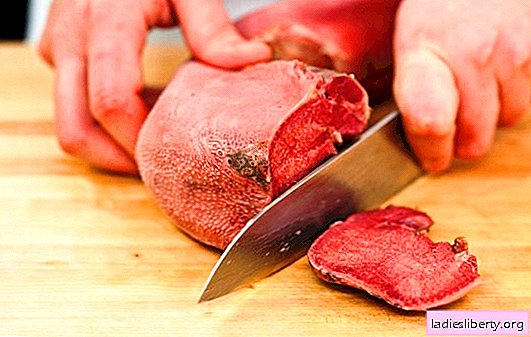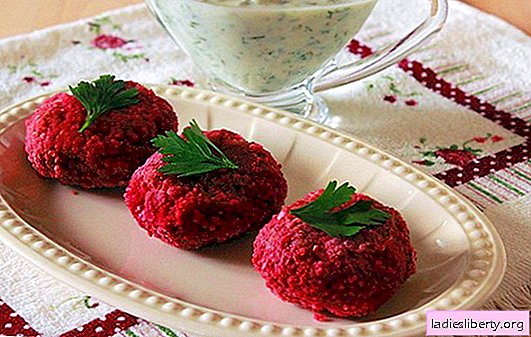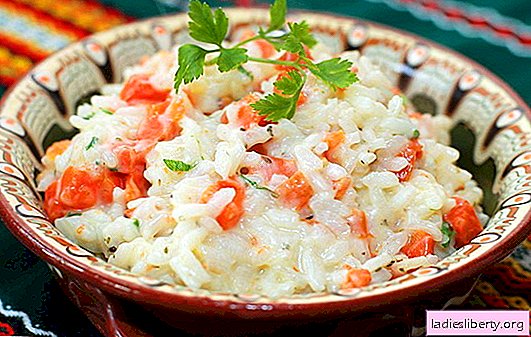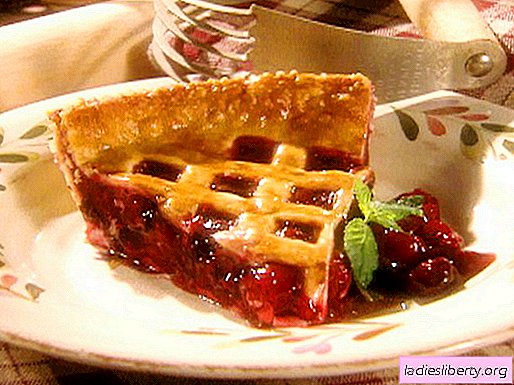
On the meat stalls, for some reason, the tongue, pork or beef, never stays for a long time.
But in conversations between young housewives, one often hears that they don’t like to cook the tongue, because it is a lot of trouble, that it is not always possible to cook the pig tongue correctly, that after cooking it is difficult to clean.
Some women frankly admit: if the initial stage of processing is successful, then the maximum that they can cook is boiled pork tongue sauce, and what else can be cooked from this part of pork carcass, they simply do not even have an idea.
Let's get it right.
How to cook pork tongue - reveal the secrets of a successful purchase
The tongue is a part of pork carcass, which refers to offal and at the same time is considered dietary meat, and therefore - the most valuable. Offal - meat of the second grade, according to the standards of merchandising expertise. The second grade - in our common sense, sounds like a second freshness - and immediately a negative attitude to the product is formed on a subconscious level, given the words of a well-known character in Bulgakov’s novel that freshness (grade) should be only the first, which clearly and collectively reflect the mentality of our people in relation to food. But such a classification clearly does not fit the language. Therefore, among offal, pig language, nevertheless, belongs to the first category.
Seeing in the meat department seemingly unattractive-looking languages, do not rush to leave, choosing a tenderloin, bacon or ham. Compare, at least the prices, and think that very interesting and tasty dishes can be prepared from offal - no worse than from meat of the first category, and a significant difference in price will be a nice bonus.
Buying meat products in a specialized trading network, you can not worry about their inspection by the sanitary-epidemiological service. But here there are pitfalls. Try to choose chilled rather than frozen meat. Besides the fact that there is a risk together with meat to buy frozen water at the price of meat, it is never known how many times, in fact, the product has been frozen. During repeated freezing, in addition to the loss of valuable nutrients, the meat loses its inherent texture, and it is suitable, at best, for the preparation of minced meat, as a weighting unit from natural biomass.
The second option remains - buying a pig tongue in the market. The tongue should have a red color on the back, be moderately dense, without suspicious odors. In this case, of course, the meat is more likely to be fresh, but you should not hesitate to ask the seller for a certificate from a veterinarian. Buy meat in markets where there is always sanitary control to rid yourself of serious health problems. Remember that most animal diseases are easily transmitted to humans, and swine flu is the most minor nuisance that can result from eating unverified meat.
Chilled tongue is stored for no more than a day, and frozen can be stored for up to 30 days. Longer storage dramatically reduces the beneficial properties of the product. Before freezing, the tongues are soaked, thoroughly washed and dried, removing excess water.
How to cook pork tongue until cooked - the right and healthy food
If we recall that all food should not only satisfy hunger and fill the stomach, but, first of all, replenish the body’s reserves with the necessary vitamins, micro and macro elements, useful organic compounds, without burdening the energy expenditure on the digestion of food and not creating " strategic reserves "in the form of lush fat under the skin, then the pig tongue, with low calorie content and high nutritional value - the best option for people of all different age categories and professions. Nutritionists strongly recommend using this product for pregnant women and children.
For an incentive to follow the advice of nutrition experts, we attach some of the most weighty arguments about the nutritional properties of a pig’s tongue.
Pork tongue differs in the structure of tissues: it does not contain intercellular fluid, or connective tissue, consisting of collagen fibers. Under the influence of high temperatures, collagen collapses, compacts, which makes the meat stiff. That is why after cooking, the tongue retains a soft and delicate texture. Collagen is absorbed by the body slowly, under the influence of pepsin, while meat containing connective tissue must undergo thorough grinding.
Known that children at an early age can’t thoroughly chew rough food, so boiled tongue is the best option to provide the child’s body with a complete and easy to digest protein. The structural features of the protein in the pig language are useful for the elderly, when restoring the body in the postoperative period.
Protein of animal origin quickly saturates the body, satisfying the feeling of hunger. In pig language it contains up to 14%, despite the fact that the product is 75% water. Its caloric content does not exceed 210 Kcal per 100 g of product.
100 g of boiled pork tongue provides the daily requirement of the body for zinc, which is involved in the production of insulin. Therefore, the product is useful for people with diabetes. It contains the main micro and macro elements necessary for the human body. Of the vital vitamins, the supply of which must be replenished daily, pork tongue contains a complete set of B vitamins, as well as vitamins E, PP.
The nutritional value of pork tongue is only slightly inferior to the quality of pork of the first category.
How to cook pork tongue - the intricacies of pre-processing
There are certain difficulties with preparing the language for heat treatment, but as they say, "the eyes are afraid, but the hands are doing."
If the tongue is purchased with a part of the larynx, then it must be cut off. It is better to withstand in water to facilitate the work with washing - the upper rough layer contains a lot of dirt and germs. Change the water while soaking. It should be cold to prevent spoilage of meat. The colder the better. After 3-5 hours, take a brush and rinse your tongue under a stream of cold water. For reliability, you can sprinkle with baking soda, but after that you need to wash it well so that it does not get into the pan.
Boil the water and put the tongue in it, boil for 10-15 minutes. Now drain the water, wash the pan, tongue, and again put it in the same pan. This technique will help to improve the quality of the broth, which can then be used to prepare first courses. Fill with cold water and put on medium heat. As soon as the broth begins to boil, remove the foam. Make the fire even smaller and put the prepared roots of parsley, celery, carrots. Wash onions, cut off the radicular part and remove only the upper scales. If you intend to use the broth after cooking the pork tongue, then the top layer of the onions will give it a beautiful golden color. Of spices, be sure to add bay leaf, a mixture of peppers with peas, optionally you can add dill, coriander or caraway seeds. Add salt only after the meat is already soft enough. The cooking time, as always, depends on the size of the piece. The tongue of an adult carcass reaches a weight of 500 g, the minimum weight in raw form is 250 g. Based on this, the cooking time is 1.5 - 2.5 hours. The duration of the heat treatment is also affected by the age of the carcass at the time of slaughter. You can check the readiness by pricking the tongue with a fork: if the meat is ready, the teeth pierce the pulp easily, without effort. After removing the foam, cook the pork tongue in the languishing mode, be sure to cover it to preserve as many vitamins as possible.
That’s all wisdom!
Next, get the tongue out of the broth. The broth can be filtered when it cools, and the tongue is immersed in ice water for 2-3 minutes, so that the film that needs to be removed is more easily separated from the pulp. Use a sharp knife to make small incisions, being careful not to touch the flesh. Remove the surface layer. If the pig tongue is well cooked, it will be easy to clean, but if you have not guessed the time a little, you will have to remove the skin with a knife. Take the knife in your right hand, with the blade inward. Pry the film with a knife blade, pull it with your left hand, cutting with a knife in your right hand. Hold the tongue with the back of your hands, pressing it to the working surface of the table.
The next step is slicing, but this is already the easiest and most enjoyable part of the job. Just work with a sharp knife, and everything will work out. The shape and size of the sliced pork tongue is completely dependent on the recipe in which the tongue will serve as an ingredient. But already boiled, it can serve as a great appetizer if served, cut into plastics, with horseradish, mustard, cranberry, mushroom, caper sauce, and, in addition, served a complex vegetable garnish.
How much to cook pork tongue until cooked and what to cook?
Having examined in detail the question of the preliminary stage of language preparation, we turn to culinary creativity.
Pork tongue dishes, as well as a great variety of dishes from other offal, served for a long time as food for the poor, because the rich noble preferred the most delicious parts of meat. This state of affairs was characteristic of different peoples who ate meat, so recipes for dishes from pork tongue are abundant in many national cuisines. The greatest contribution to the development of dishes from pork tongue was made by cooks and cooks of Russian cuisine. It is not for nothing that they say that the goal of invention is cunning. Snacks, first courses were prepared from offal, they became an excellent raw material for making toppings in pies, pancakes, dumplings, minced meat for sausages. Later, salads appeared in Russian and other cuisines, in which the pork tongue was either emphasized as the main ingredient, or it is successfully used instead of meat of the first category, but at the same time, dishes from such a replacement do not get any worse.
Older people remember how dishes from the language firmly entered the restaurant menu as a special delicacy, and already professional technologists of Soviet catering significantly expanded the range of dishes from the language and other offal.
Recipe 1. How to cook pork tongue - aspic
Product Composition:
Tongue 3 kg (net)
Bay leaf
Onions 2-3 medium heads
Pepper, allspice and black
Celery Roots and Parsley
Carrots, sweet (large) 5-6 pcs.
Green peas (fresh or frozen) 0.5 kg
Garlic
Dill (seeds and fresh stems)
Salt
Bone Set:
Beef knee joints or tails 2 kg
Pork ears, skin, lower legs 3 kg
Chicken backs 3-4 pcs.
Parsley leaves (for decoration)
Cooking:
Choose tubular bones with cartilage, as they contain a large amount of gelling substances, so that you do not have to add gelatin to the broth.
Wash meat products, soak in cold water for 7-8 hours. In a large pot, put beef and pork (except for the tongue). Pour cold water 10 cm above the level of the bones. Set the cook by turning the stove on to the minimum level. Collect the rising foam. After one and a half hours put prepared pork tongues. Let it boil again and watch to remove foam in time. After another 1.5 hours add the chicken backs. For aspic it is better to choose the meat of old cocks. A set of meat from different animals will make the broth taste more rich and vibrant.
30-40 minutes after laying the backs, add peeled roots to the broth: chop parsley and celery into large pieces; cook the carrots whole, and remove the top layer of the skin from the bulbs and cut off the roots. 20 minutes before the end of cooking, put in the pan a bay leaf, 10-15 peas of pepper, stalks of fresh dill tied in a bunch, dill seeds. Salt.
Peel the middle head of garlic, chop the cloves and throw into the aspic. Turn off the stove. Remove the tongues and transfer them to cold water. Peel and dice.
Put the carrots on a plate - when it cools down, cut them into cubes the size of a pea, you can cut jewelry using a curly carving knife.
While the aspic is cooling, boil green peas in salted and sweetened water. Drain and temporarily set aside in a separate bowl. Wash the parsley and prepare the leaves for decoration.
Remove bones from the broth, strain it through cheesecloth or nylon sieve. In prepared deep plates or special forms, lay on the bottom leaflets of cockerels and curly carrot decorations. Lay out the tongue, peas and carrots on top. Carefully pour the broth, taking care not to disrupt the layout of the meat and vegetables. Move the molds to the refrigerator for a while. When it hardens, add the remaining broth and put it back in the cold. When serving, hold the pan for several seconds in hot water and turn over onto a dish or portioned utensil.
Recipe 2. How much to cook pork tongue until ready for a complex snack
Product Composition:
Boiled tongue, pork 1.2 kg (net)
Bone Broth 1.5 L
Gelatin 20 g
Liver, beef stewed 600 g
Onions, steamed 200 g
Butter 100 g
Carrot 300 g
Boiled eggs 60 g
Garlic 30 g
Mayonnaise 120 g
Cheese, hard 250 g
Greens 150 g
Spice
Pickled onions (small onions)
Cooking:
Read the recipe for cooking broth in detail above. Ready to filter the broth. Separate 250 ml of broth and dissolve 20 g of gelatin in it. When dissolved, combine with the main mass, mix and pour on a large round dish in which you will serve a snack. For convenience and beauty, cut the frozen broth with diamonds.
Cut the tongue into 12 thin slices. Roll each of them with a cone and secure it with a skewer at the junction of the edges. Inside the cones from a pastry bag with a curly nozzle, drop the liver paste.
Pate preparation:
Combine the fried slices of the liver with sautéed onions, carrots (200 g), season with spices and add softened butter. Interrupt with a blender to a pasty consistency.
Peel the boiled eggs. Zigzag the protein from the wider side. Take out the yolks and with the cut pieces of protein put them in a bowl. Add the grated cheese, garlic and mayonnaise. Pour the egg and cheese mass into a paste, which stuff the squirrels cut in the shape of a bell. As well as liver paste, pour the cheese mass with a pastry bag inside the proteins.
Head onions in a marinade of cold boiled water, sugar, salt, fruit vinegar and 50 ml of fresh beetroot juice. Make "chrysanthemums" from the bulbs. To do this, cut the root part to give stability to the “flower”. Make cross-shaped incisions from top to bottom, to the base. Bend the "petals" outward, separating the layers of the bulbs. Lay out the cones and bells in a circle, alternating between them and decorating with leaves of parsley or other greens. Put pickled onion flowers in the center of the dish.
Recipe 3. How to cook pork tongue - zrazy, potato
Product Composition:
Mashed potatoes 900 g
Tongue, boiled pork 600 g
Onion, 100 g
Spice
Flour 100 g
4 eggs
Rusks, white, breading 120 g
Sour cream (for serving)
Garnish - fried mushrooms
Cooking:
If yesterday's puree is left, then there is a wonderful opportunity to save time for its preparation. Add 2 eggs, flour to it, leaving 2-3 tablespoons for boning the semi-finished products. Mix the potato dough well and let it brew for half an hour so that it acquires the necessary viscosity.
Passer finely chopped onions in a preheated pan. Use creamy margarine to fry. Add chopped pork tongue to the pan when the onion is browned. Add the necessary spices, at your discretion. Put the prepared stuffing on a plate and let cool.
On a work surface, sprinkled with flour, form tortilla from mashed potatoes. In the center, put the cooled minced meat from a chopped tongue. Stick to the edges, giving the zrazas an oval and convex shape. For convenience, in the process of sculpting, grease your hands with oil, or moisten them in water.
Whip 2 eggs into the foam. Pour crackers onto a plate. Wet the cake mix in egg foam and bread. Repeat the operation.
Deep-fried potato zrazy with tongue.
Serve with sour cream or sour cream sauce.
How to cook pork tongue - for housewives
Pork tongue is perfectly stored in the freezer, and in order to preserve its properties in the best way, seal it first in airtight packaging.
Pig language is a health and budget benefit, and its taste depends on skill, but most importantly, on mood, to a greater extent.











